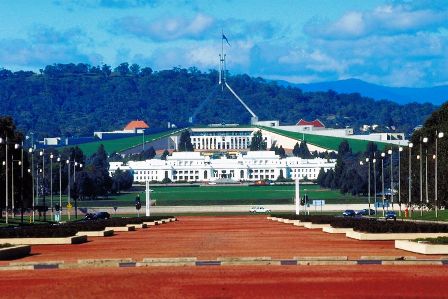Canberra, Australia’s capital city, is so obscure that many overseas visitors have never heard of it.
The city, an unloved offspring born from a dispute between Sydney and Melbourne, is a meticulously designed, made-to-order metropolis that suffers from some of the same flaws that other purpose-built capitals possess: an over-supply of bureaucrats and students, and a slight under-supply of urban chic.
But a closer look at the capital reveals that Canberra’s quirks are, in fact, a fitting testament to Australia’s history and culture. Unlike the United States’ capital, Washington, DC — with its imposing neo-classical edifices — Canberra’s public buildings are all understated modernism. Parliament House is built under a hill, which perhaps hints at Australians’ distaste for political pomp and circumstance, while Canberra’s connection to its striking natural surroundings has lent it the moniker of Bush Capital.
Here is how to make a couple of days in Canberra worth a detour off the highway between Sydney and Melbourne:
Day one
Plan to visit when Parliament is in session and book tickets for Question Time in the House of Representatives at Parliament House (weekdays at 2pm and free of charge) – the only show in town for politics junkies. While you are there, take a guided tour of the unique building and learn what makes Australia’s political heart tick. Afterwards, head to the Museum of Australian Democracy at the Old Parliament House to put it all in context. During the warmer months, the Old Parliament House hosts cocktails on the lawn, complete with DJs and serious young political movers and shakers.
National Gallery of Australia, Canberra
The National Gallery of Australia offers one of the region’s best collections of Asian art and rich collections of Australian art, including 200-odd years of Western painting and sculpture, as well as fascinating Aboriginal and Torres Strait Islander works. Next door is the National Portrait Gallery, which is like walking through Australia’s family photo album and provides a fascinating survey of the history of portraiture. Afternoon tea is close by at the historic Hyatt Hotel, where waitresses in white lace aprons serve cakes and sandwiches in a 1920s setting.
Pilic Char-grilled Spatchcock – Ottoman Cuisine
When night falls, book a table at Italian and Sons for a casual inner-city pizza or pasta (the ingredients are incredibly fresh and the cooking top-notch). Alternatively, try Ottoman Cuisine, a long-standing favourite on Canberra’s fine dining scene, and a good place to spot political heavyweights.
Day two
Start the day on a slow note with brunch at Silo in Kingston or, if the line for delectable pastries is too long to handle, try Manuka’s Urban Pantry. Once you are fed, it is time for some more “cultcha”.
 The National Museum of Australia takes a wry approach to explaining Australia’s identity, so visitors can come up with their own theories as they meander past displays of everything from possum-skin cloaks to a Hills Hoist clothesline. The nearby National Film and Sound Archive has a delightful courtyard cafe, a cinema showing art house films and a tiny 1920s theatrette that has old home videos, newsreel, ads and other archived materials on a loop, offering a moving and hilarious nostalgia-fest.
The National Museum of Australia takes a wry approach to explaining Australia’s identity, so visitors can come up with their own theories as they meander past displays of everything from possum-skin cloaks to a Hills Hoist clothesline. The nearby National Film and Sound Archive has a delightful courtyard cafe, a cinema showing art house films and a tiny 1920s theatrette that has old home videos, newsreel, ads and other archived materials on a loop, offering a moving and hilarious nostalgia-fest.
For those keen to explore the great outdoors, the National Botanic Gardens are filled with lovely walks, and the nearby Namadgi National Park is packed with grey kangaroos and some worthwhile Aboriginal rock art. If you have wheels, the region’s excellent wineries can easily fill a lazy afternoon.
And do not leave Canberra without visiting the moving War Memorial – stay for closing time, when the Last Post is played to honour the fallen.
Sarah Gilbert
10 Feb 2012
http://www.bbc.com/travel/feature/20120208-australias-capital-highlights



